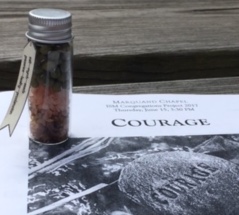Balm in Gilead: Binding Wounds Through Time and Tree
 Brianna Lloyd, MDiv ‘18
Brianna Lloyd, MDiv ‘18
Salt, myrrh, seeds. Presence, healing, proclamation. Captured in small, capped bottles that we may still have on countertop or in office are the elements of earth that weaved through our worship. Salt and myrrh made manifest our first prayers—
scattered on a map of the world, poured from papers of pink and yellow. “Where can you be present when there is mourning? Where do you pray for healing?” We filed toward the center of the chapel as “Dona Nobis Pacem”— “Grant us peace”— alighted around us, and placed our prayers, these elements, earth on earth. The map became textured—mountains of pink salt and the rusty flecks of myrrh.
Worshiping together was a way to practice and experience where our conversations and lectures took us. I experienced our four worship services as learning moments and as necessary salve to the memories and feelings that surfaced during the three days of the conference. They were curriculum and balm, both. They reflected the way, as Reverend Patrick Ward shared in his experience at Trinity Episcopal Church in Boston, our traditions run ahead of us. When violence and chaos strike, songs and rituals can hold us.
Tony Alonso offered similar words in his lecture on “Singing Our Prayer.” “Songs are planted deeply within people’s hearts,” he shared. “They can anchor fragments of faith.” Too, however, they can participate in and perpetuate violence. He offered a reminder, an admonition, to “contemplate the gaps.” Singing of some experiences, and not of others, can render violence through silence and neglect. “Silence is a violation of one’s meaningful existence in the world,” Dr. Sarah Farmer noted in her lecture on ministry with adolescents. Worship can wound, too.
Worship gathered us, shaping and challenging our time together. Woven within it were salt, myrrh, and seeds—particles of a tradition of deep time, elements of earth, silent witnesses and participants in life, renewal, and violence. These elements surround us and shape us, consciously or not. They run ahead of us. They appear in psalms and sacred scripture. Myrrh is an element of healing, Maggie Dawn informed us. It is the resin that certain trees native to the Middle East and Eastern Africa emit after they have been wounded. This resin binds the trees’ wounds. Authors of psalms and scriptures, inhabitants of this place, long used this resin for fragrance and human medicine as well. It enters their stories and praises, their prayers. It becomes a gift brought to Jesus. The trees themselves are sharp and spikey, guarded, and even this mirrors the fact that we are wounded and wounders, both. The violence lies within us and outside us, as Don Saliers was careful to note in his lecture on the psalms.
This tradition—to which salt and seed and myrrh belong— manifested in other ways during the conference. It moved in the flock of starlings that rose and scattered behind the glass and bodies of dancers at Grace Farms, in the fragrant but invasive mugwart that was popping up alongside the steamy path down the hill to Bethesda Lutheran Church where we ate lunch, from our voices that joined to sing the Doxology in the old horse stables at Grace Farms—a renovated space that resembled, as our song leader Beverly Lapp noted, old Mennonite meetinghouses. We were joined by the memory of horses, husbandry, and the shape of worship spaces–tradition upon tradition—as melody echoed through the room, “Praise God from whom all blessings flow. Praise God all creatures…” The next day, Reverend Cheryl Cornish would remind us that beauty—whatever its scale or excellence—is a crucial counter to violence. Here were some moments, among many others, of beauty that can heal.
Near the conclusion of the conference, during the last break-out session, James Abbington told my discussion group that “Balm in Gilead” was one of Martin Luther King Jr.’s favorite hymns. Interestingly, this balm is made from a special type of myrrh, specifically from trees grown on the banks of the Dead Sea. It was a powerful healer known and used by the Hebrew people. Traditions converge in this fact—the support and solace the hymn offered Dr. King and the millennia-long history of myrrh’s healing relationship to a particular people and a place. Traditions converge, wounds are tended, and healing comes.
There is a Balm in Gilead
to make the wounded whole.
There is a Balm in Gilead
To heal the sin-sick soul.
Sometimes I feel discouraged,
and think my work’s in vain,
but then the Holy Spirit
revives my soul again.